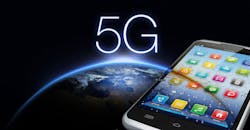Will You Own a 5G Smartphone in 2019?
As we finish 2018 and look to 2019, you’re probably fully aware of the massive amount of attention geared toward 5G. Those who have been staying up-to-date surely heard plenty enough about it over the last few years. Now, though, it seems like all the hoopla is turning into reality.
So, what can we expect to see in 2019 regarding 5G? In a recent interview with Microwaves & RF, James Kimery, director of marketing at National Instruments (NI) stated, “5G has unstoppable momentum and initial 5G deployments will start in 2019.” He also noted, “Most initial deployments may be on sub-6-GHz bands, but there will be some fixed wireless use cases using millimeter-wave (mmWave) technologies.”
The “unstoppable momentum” mentioned by Kimery is evidenced by the expected availability of 5G smartphones in 2019. Companies like Samsung, LG, Huawei, and more are expected to launch these phones. Will you be holding a 5G smartphone in your hands in 2019? If you pay attention to the news, there’s a good chance of that happening (except for my colleague Jack Browne, who still refuses to own a cell phone!).
While it may be exciting to see 5G smartphones in 2019, the question is what frequencies will these devices utilize? Specifically, when will the mmWave bands that we’ve heard so much about really make a big impact? The answer is maybe sooner than you think.
Verizon and Samsung recently announced a successful data transmission using 800 MHz of bandwidth at 28 GHz, resulting in a maximum throughput of almost 4 Gb/s. This news certainly highlights what mmWave bands can bring to the table.
“The demonstration using a 5G New Radio (NR) compliant system for both the Samsung gNB and NI test UE demonstrates that 5G NR mmWave has much potential to realize the data-rate goals set forth by the IMT-2020 and the 3GPP for the enhanced mobile broadband (eMBB) case,” said Kimery. “This real-world demonstration clearly shows that mmWave is real and that these impressive data rates are achievable.”
In any case, even if we have to wait a little bit longer to see mmWave frequencies make a significant impression in this space, the thought of owning a 5G smartphone is sure to interest plenty of people out there (of course, except for Jack!).

